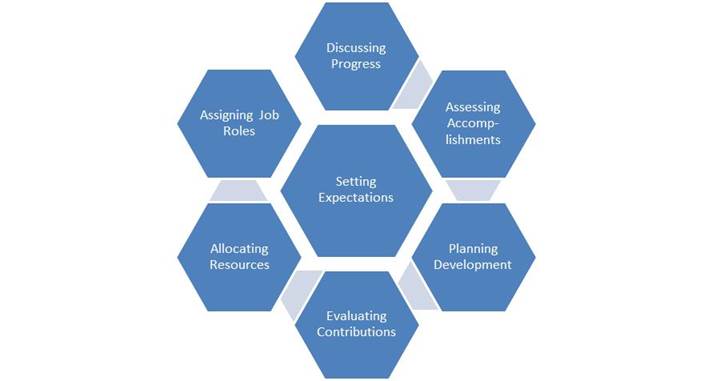I recently wrote an article explaining that performance management is difficult because it involves evaluating employees based on their relative contributions to the company while also engaging and encouraging employees to improve their performance.
This can create a dilemma since methods that accurately evaluate employee performance often decrease employee engagement, and methods that emphasize employee development often provide little value for identifying high performers.
So how do we solve this?
Here’s what won’t work
Before I suggest an answer, let me clarify what is not likely to work.
Do not simply copy a performance management method used or recommended by someone else. Also beware of “quick fixes” that emphasize single methods or radical actions such as implementing strict forced ranking or totally abolishing annual appraisals.
Performance management is a delicate topic. What methods work best vary depending on each company’s business needs, existing culture, available HR resources, and employee population. Methods that work in competitive sales cultures may fail in cultures that emphasize service oriented collaboration. Techniques appropriate for fast growing entrepreneurial start-ups can create chaos in large, established organizations.
Effective performance management comes from striking a balance to create a process that fits the unique needs of your company. Even the most effective methods will need some changing over time to account for shifts in company strategy and workforce population.
So what is the answer to “fixing” performance management? It lies in recognizing that performance management is not one process. It is a series of independent processes that must be linked together without becoming overly intertwined.
There are at least seven distinct phases of performance management, each addressing a different set of questions, conversations and decisions that impact workforce productivity (see illustration below).
Phase 1 – Setting expectations
Do employees understand what goals they are expected to achieve and what behaviors they are expected to display? Do they know how their contributions to the company will be formally measured?
Setting expectations is not about creating bonus targets to justify future compensation decisions. It is about ensuring employees understand what they must accomplish and why these actions are important for the success of the organization and for achievement of their career goals.
Phase 2 – Discussing progress
Do employees and managers regularly communicate about progress against expectations? This includes updating formal job expectations to reflect changes in the company strategy.
Discussing progress is a basic part of being a manager, but many managers only talk to employees about short-term tactical details without stopping to discuss the longer-term goals they are trying to achieve.
Phase 3 – Assessing accomplishments
Do employees periodically meet with their managers to review expectations and gain feedback on how to improve their future performance? Ideally this discussion will also include input from co-workers and customers.
Assessing accomplishments can take place any time during the year and does not require making an overall evaluation of employee performance. But it must provide adequate performance feedback on specific goals and expectations so employees can effectively focus efforts to leverage strengths and address challenges.
It should also leave employees with a clear understanding of whether they are meeting, exceeding or failing against different job expectations.
Phase 4 – Planning development
Do managers and employees periodically talk about future career growth opportunities?
This can be done formally or informally throughout the year. But it is important is to ensure it does happen every so often. Otherwise employees may become disengaged due to a lack of focus on their longer term career development.
Phase 5 – Evaluating contributions
Does the company work with managers to periodically identify the high and low performers in the organization?
This is important for retaining talent, addressing counter-productivity, and guiding future actions to build the workforce. It requires comparing employees’ relative contributions to the company based on past accomplishments and behaviors.
Employees who achieve challenging and business critical goals should be recognized over employees who achieve simpler or less important goals. Employees who fail to meet expectations or who hinder performance of other employees also need to be identified.
Phase 6 – Allocating resources
Does the company invest scarce resources like pay in the employees who are likely to provide the greatest return on this investment?
It is important to treat compensation and training resources as investments to retain, motivate, and develop employees based on the contributions they are expected to make in the future. And the best way to predict future contributions is to look at past performance.
So, while it is important to recognize that many things influence pay other than performance, performance should be a key factor in pay decisions.
Phase 7 – Assigning job roles
Does the company assign future job roles based in part on evaluating what people have demonstrated through previous work? This includes giving people job assignments that provide developmental experiences that complement past performance strengths.
Staffing decisions send a strong message about what is important to the company. These decisions should be heavily influenced by whether an employee’s past performance supported the goals and values of the organization.
Your focus should be on handling a phase well
Every company performs all seven phases, but may not do each phase well. The question is not whether your company carries out a phase, but whether the phase is carried out using well-defined, transparent, and effective methods. A failure to define relationships between different phases can also undermine the value of the overall performance management process.
Companies with the most effective performance management processes take time to:
a) Ensure each phase of performance management is performed effectively in a well-defined manner.
b) Create links so people understand how actions in one phase influence decisions made in another.
To create an effective overall performance management process first think through each phase by itself.
What actions for that phase make the most sense for your company? Then provide managers and employees with tools to conduct each phase and hold them accountable for using these tools.
At the same time be sure to define and communicate how the different phases influence each other. For example, many companies require managers to evaluate contributions through performance ratings but do not hold managers accountable for setting clear expectations.
This failure to define expectations undermines the accuracy of the performance ratings. Managers should also be able to explain to their employees what the relationship is between setting expectations, assessing contributions, development planning, and allocating resources.
Here’s what success looks like
Creating an effective performance management processes involves developing methods to effectively perform each of these seven (7) phases, and defining how conversations or decisions made in one phase influence actions and decisions in other phases. Only by dividing performance management into these parts can we address its overall challenges.
